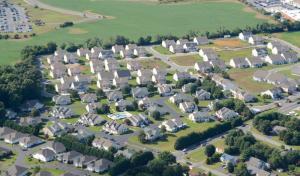Sides clash on proposed density ordinance
Residents had another chance to comment on a proposed ordinance that would change how the number of units permitted in a subdivision are calculated.
Sussex County Council heard from many of the same people Oct. 9 who testified during two planning and zoning commission hearings.
Opponents said the change would devalue property and lead to sprawl. Proponents said the proposed ordinance would provide better protection for wetlands.
Under the proposal, developers would no longer be permitted to count state wetlands when calculating total density. Under current regulations, density is calculated using the total parcel acreage, even though state wetlands can't be built on.
At the start of the more than 2-hour public hearing, Sussex County Councilman Rob Arlett, R-Frankford, posed two questions.
“Is the goal to reduce building or is the goal to ensure the environment is protected and safeguarded?” he asked.
Councilman I.G. Burton, R-Lewes, who introduced the proposed ordinance, said it's never made sense to allow density calculation including wetlands where houses can't be built. “My idea is not necessarily less houses but protection of areas around state wetlands,” he said.
After the hearing, council voted unanimously to close the public hearing but leave the public record open for written comments until Wednesday, Nov. 7. “We've heard a lot about environmental issues,” Arlett said. “I'd love to hear from DNREC since they are charged to protect those areas.”
Burton said the idea has been expressed in three land-use plans. “It's been on the minds of the county for a long time. It's time to bring it forward for discussion,” he said.
In favor: More protection for resources
Mike Johnson of Georgetown, who served with Burton on the planning and zoning commission, said he's never supported the current density ordinance. But, he said, until now, there has never been any interest in changing it. “If you continue to allow this type of calculation, you invite more abuse,” he said. “It's not an issue of taking away but a common sense issue that you can't build on wetlands.”
Michelle Schmidt, Delaware Center for the Inland Bays watershed coordinator, said the proposed ordinance is consistent with the Inland Bays comprehensive conservation and management plan. “The ordinance would prevent the concentration of density near ecologically sensitive wetlands and waterways, such as those in the Inland Bays, and reduce exposure of future county residents and their property to flooding,” she said.
Matt Babbitt, representing the Delaware Nature Center, said the ordinance is a good first step to on-ground changes to protect natural resources.
Jeff Stone, representing Sussex Alliance for Responsible Growth, said the proposed changes to density calculation and buffers are consistent with the proposed draft of the 2018 comprehensive plan.
Stone said the organization acknowledges concerns expressed by opponents. “But we disagree that it would impose a burden on landowners,” he said. “If anything, the preservation of environmental features increases the value of properties adjacent to or even just near them,” he said.
He said it's incumbent on council to protect the county's natural resources. “If they are lost, and many are on verging on being permanently degraded, they cannot be restored. It would be cruel irony to bequeath to the next generations only memories and pictures of what Sussex used to be,” he said.
Rich Moore, president of Delaware Interfaith Power and Life, said a new United Nations report found if greenhouse gas emissions continue at the current rate, the atmosphere will warm up by as much as 2.7 degrees by 2040.
He said decisions made by government entities, such as county council, can play a key role in combating climate change.
Moore said more attention to preservation of wetlands and larger buffers are immediate steps council can make to mitigate, avoid and sequester carbon. “These are fundamental changes, but you need to go further than this ordinance,” he said. “These choices need to be made now, or it's going to be too late to protect this county for everyone here,” Moore said.
With global temperature rising, Moore said, we are cooking ourselves to death. “It's a serious reality we are in,” he said.
Against: Sprawl and equity issues
James Baxter IV, a Georgetown farmer, said removing wetlands from the calculation decreases equity in his land. “My land is an asset – it's my equity for borrowing money,” he said. “I hope you have a conversation with a bank to find out how much this would devalue my property.”
Baxter said farmers protect their own wetlands. “I protect my personal wetlands like I protect my family, and protect my way of life,” he said.
Baxter said the 2,000 members of the Sussex Farm Bureau are opposed to the ordinance.
He said the county should step back and conduct a workshop with stakeholders, including bankers.
Engineer Ring Lardner agreed. He suggested council take a step back and take a holistic look – with input from stakeholders – at density and buffers, similar to what was done when council amended the drainage ordinance.
He estimated state wetlands make up only 10 percent to 20 percent of all wetlands in the county. He said state wetlands are already protected because they can't be built on.
Lardner, representing the Delaware Chapter of the American Council of Engineering Companies, said the proposed ordinance would promote sprawl and negatively impact the environment by forcing developers to buy more land to meet market demands. And, he said, that land could be further away from infrastructure, requiring more roads.
“You don't need less density, you need higher density,” said Dan Kramer of Greenwood. “If this passes, mark my word you will get sued – you can take that to the bank,” he said.
Jim Erikson, a civil engineer from Millsboro, said the ordinance would lead to sprawl resulting in more vehicles driving longer distances with more infrastructure costs. “Traffic is worse with lower density,” he said.
NOW
20-acre subdivision with 5 acres of wetlands in AR-1 zoning.
5 acres of wetlands are counted in density calculation, 2 units per acre. 2 units X 20 acres = 40 units
Actual density = 2.7 units per acre on buildable land
PROPOSED
20-acre subdivision with 5 acres of state wetlands in AR-1 zoning.
5 acres of wetlands would be subtracted from density calculation. 2 units X 15 acres = 30 units
Actual density = 2 units per acre on buildable land























































